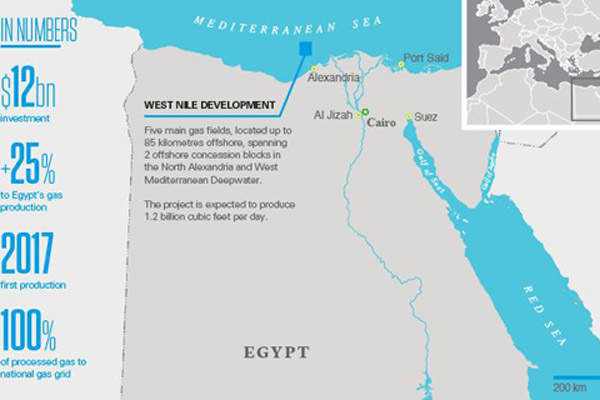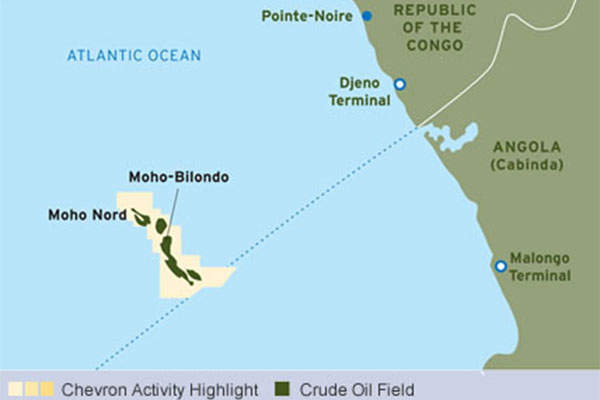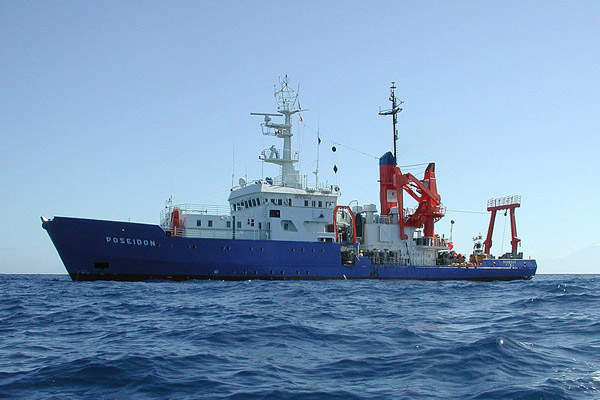The West Nile Delta (WND) project involves the development of gas and condensate fields located within the North Alexandria (N Alex) and West Mediterranean Deepwater concessions in the Mediterranean Sea, approximately 65km to 85km off the coast of Alexandria, Egypt.
The gas development project is being carried out in three phases. The first phase involved the development of Taurus and Libra gas fields, and the second saw the development of the Giza and Fayoum fields.
Raven field will be developed in the third phase, while the Maadi, Viper, Ruby, Polaris and Hodoa discoveries will be developed in later phases.
The West Nile Delta project is being co-developed by BP (82.75%) and DEA (Deutsche Erdoel AG) (17.25%).
In March 2015, the two partners signed final project agreements with the Egyptian Minister of Petroleum, the Egyptian General Petroleum Corporation and the Egyptian Natural Gas Holding Company. The overall investment for phase one was $12bn.
Construction of the first phase started in February 2017 and production from the Taurus and Libra fields commenced in May 2017. First gas was delivered to the national grid ahead of schedule in March 2017.
First gas from the Giza and Fayoum fields was achieved in February 2019, while the Raven gas field is expected to commence production by the end of 2019.
WND reserves and production
BP and DEA will develop five trillion cubic feet (tcf) of gas and 55 million barrels (mmbbl) of condensate reserves from three phases of the WND project. The new fields and future exploration activities are expected to further boost production from WND by an additional five tcf to seven tcf.
Peak production from the project in 2019 is expected to reach 1.4 billion cubic feet a day (bcf/d) of gas, which is equivalent to approximately 20% of Egypt’s current gas production.
West Nile Delta (WND) project development plan
A total of nine production wells were drilled for the Taurus and Libra gas fields during the first phase. The wells are connected to an offshore infrastructure located at water depth ranging between 60m to 800m, via a 42km-long tie-back.
The subsea system for the Taurus and Libra production facility includes two subsea manifolds, 79km-long gas pipeline, 68km of control umbilicals and flexible well flow-lines of 24km.
The second stage of the WND project includes the development of eight production wells for the Giza and Fayoum gas fields. The fields have an initial production capacity of 400MMscfd, which will be further increased up to 700MMscfd by April 2019.
The Taurus and Libra fields are connected to existing Burullus facilities operated by Burullus Gas (BG), whereas the Giza and Fayoum fields are tied back to the existing Rosetta plant onshore, which is modified to accommodate additional production. The Raven field will be connected to a new onshore plant adjacent to the existing Rosetta plant.
BP and DEA signed an agreement with BG Egypt in March 2015, under which the operational rights of the onshore facilities at Rosetta was transferred to the former two companies starting from mid-2016.
West Nile Delta fields discovery
The Taurus, Libra and Fayoum fields were discovered in 2000 and 2001. The Ruby discovery was made in 2002 by drilling the Ruby-1X well and was further appraised in October 2013 and February 2009.
The Raven discovery was made in March 2004. The Raven 1X exploration well, drilled at a water depth of approximately 650m, flowed at rates up to 37.4 million cubic feet a day (mcf/d) of gas and 741 barrels of condensate a day during initial test.
The Polaris discovery was made in July 2004 by drilling the Polaris 1X exploration well to a total depth of 2,178m.
Geology
The Giza, Taurus, Libra, Fayoum, Maadi, Viper, Polaris and Ruby fields hold gas resources within the Pliocene formations. The Raven and Taurus Deep discoveries hold gas resources in the deeper Miocene formations, and the Hodoa discovery holds gas resources within the Oligocene formations.
Contractors involved
KBR performed concept selection activities for the West Nile Delta project under a contract awarded in August 2010. The feasibility study for the project was earlier completed by Granherne, a consulting subsidiary of KBR.
The geophysical and hydrographic surveys over the concessions were performed by Fugro, employing its M/V Western Shore vessel, M/V Geo Prospector and Echo Surveyor HUGIN 3000 autonomous underwater vehicle (AUV). The geochemical, sedimentological and micropalaeontological studies on two mud volcanoes located within the project site were performed by Leibniz Institute of Marine Sciences (IFM-GEOMAR) employing the research vessel FS Poseidon.
Subsea 7 was contracted for the installation of subsea and topsides facilities for the project and Van Oord was subcontracted by Subsea 7 to carry out the installation of subsea rocks.
Other key players involved in the project are YSF, Cameron, WorleyParsons, Hobbs Valve and Aker Solutions.




